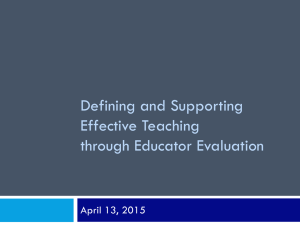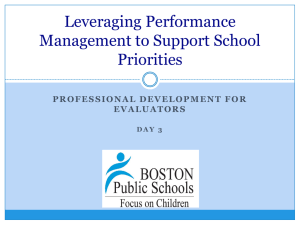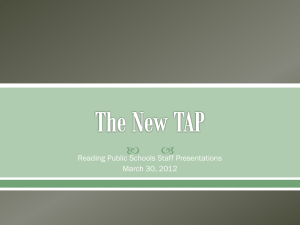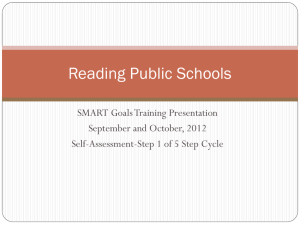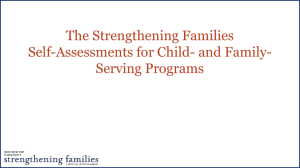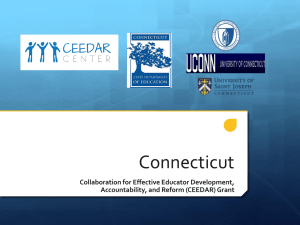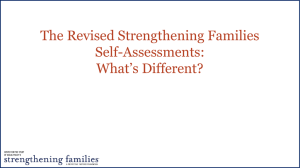File - BPS Supporting Effective Teaching Resources
advertisement
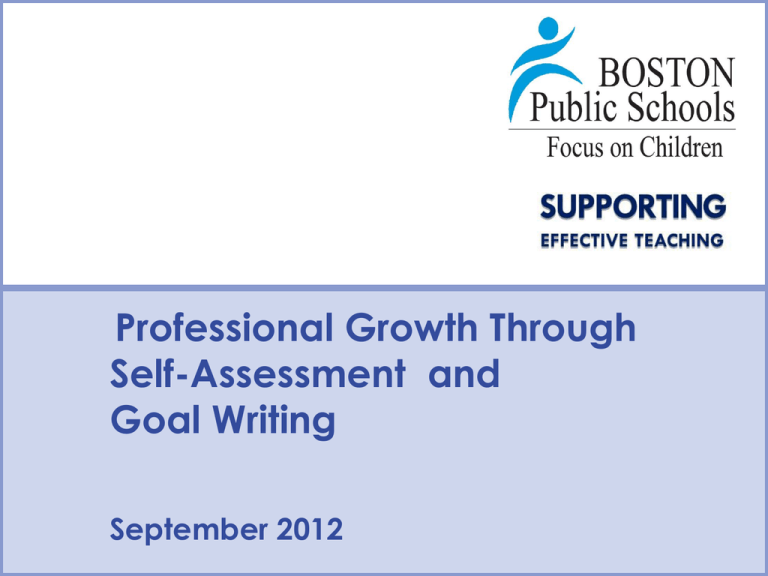
Professional Growth Through Self-Assessment and Goal Writing Type Date Here Type Presenter September 2012 Name/Contact Here Objectives for today If we have done our job today, you will: • Draft your self-assessment summary • Draft or revise student learning and professional practice goals and action plans. • Understand how to enter the selfassessment and goals into the EDFS • Understand how to access more resources Resources, Support, Questions, and Feedback • For more information, visit: - EDFS: http://eval.mybps.org/ - http://educatoreffectiveness.weebly.com • Email questions, comments and feedback to: - bpsevaluation@boston.k12.ma.us • MA Department of Elementary and Secondary Education (DESE) Evaluation Site: - http://www.doe.mass.edu/edeval/ Educator Feedback and Development System http://eval.mybps.org/ User ID & Password – Same as MyBPS & The Hub http://educatoreffectiveness.weebly.com • For more information, visit: - EDFS: http://eval.mybps.org/ - http://educatoreffectiveness.weebly.com • Email questions, comments and feedback to: - bpsevaluation@boston.k12.ma.us • MA Department of Elementary and Secondary Education (DESE) Evaluation Site: - http://www.doe.mass.edu/edeval/ Today’s Agenda Brief Overview of Key Changes o Rubric of Effective Teaching o 5 -Step Cycle o EDFS Online System o Ratings & Plans Self-Assessment Goal Writing Using EDFS Key Change #1: Rubric for Effective Teaching with 4 Standards Former Teacher Evaluation (8 Dimensions) 1. Equity and High Expectations 2. Professionalism 3. Safe, Respectful, Culturally Sensitive and Responsive Learning Communities 4. Partnership with Family and Community 5. Instructional Planning and Implementation: 6. Content Knowledge 7. Monitoring and Assessment of Progress 8. Reflection, Collaboration, and Personal Growth Teacher Evaluation NewNew Principal/Admin Evaluation (4 Standards) 1.*Curriculum, Planning & Assessment 1.*Instructional Leadership 2.*Teaching All Students 2. Management and Operations 3.Family & & Community Community Partnerships Engagement 3.Family 4.Professional Culture Culture 4.Professional Key Change #2: 5-Step Cycle, Continuous Learning Self-Assessment Summative Evaluation Formative Assessment/Evaluation Analysis, goal-setting & plan development Implementation of the plan Key Change #3: Employee Development & Feedback System (EDFS) Key Change #4: 4 Rating Categories, 4 Educator Growth Plans Former categories Does not meet standards Does meet standards Proficient New categories Fully and consistently meets the Needs Unsatisfactory requirements of Proficient a standard Improvement Exemplary Educator plans are determined by performance rating and career stage Ratings Educator Plans PTS educators Exemplary Non-PTS educators Self-Directed Growth Plan 1 or 2 years Proficient Needs Improvement Directed-Growth Plan Up to 1 year Unsatisfactory Improvement Plan 30 days – 1 year Developing Educator Plan 1 year 11 Transition year: educator plan is determined by previous performance rating and career stage Existing Rating Educator Plans PTS educators Teachers with Overall “Meets Standard” Non-PTS educators Self-Directed Growth Plan 1 or 2 years Developing Educator Plan Teachers with 1 Overall “Does Not Meet Standard” Directed-Growth Plan Up to 1 year Teachers with 2+ Overall “Does Not Meets” Improvement Plan 30 days to 1 year 1 year 12 Goals and Ratings Progress on Ratings on Overall (2) Goals (4) Standards Rating Student Learning Professional Practice • Curriculum, Planning and Assessment • Exemplary • Proficient • Teaching All Students • Family & Community Engagement • Needs Improvement • Professional Culture • Unsatisfactory Today’s Agenda Brief Overview & Key Changes o Rubric of Effective Teaching o 5 -Step Cycle o EDFS Online System o Ratings & Plans Self-Assessment Goal Writing Using EDFS Understanding Self-Assessment Self-Assessment Summative Evaluation Formative Assessment/Evaluation What are my strengths and areas for development? Analysis, goalsetting & plan development Implementation of the plan Understanding Self-Assessment Consider: • School Priorities • District Rigor through Common Core Shifts Standard I Using Data & Differentiation Standard II Family & Community Engagement Standard III Educator Effectiveness Standard IV • Student learning strengths & needs • Professional practice in relation to the standards outlined in the rubric Teacher Rubric At-A-Glance Standard I: Curriculum, Planning, and Assessment Standard II: Teaching All Students Standard III: Family and Community Engagement Standard IV: Professional Culture A. Curriculum and Planning Indicator 1.Subject Matter Knowledge 2.Child and Adolescent Development 3.Rigorous Standards-Based Unit Design 4.Well-Structured Lessons A. Instruction Indicator 1.Quality of Effort and Work 2.Student Engagement 3.Meeting Diverse Needs A. Engagement Indicator 1.Parent/Family Engagement A. Reflection Indicator 1.Reflective Practice 2.Goal Setting B. Assessment Indicator 1.Variety of Assessment Methods 2.Adjustments to Practice B. Assessment Indicator 1.Safe Learning Environment 2.Collaborative Learning Environment 3.Student Motivation B. Assessment Indicator 1.Learning Expectations 2.Curriculum Support C. Collaboration Indicator 1.Professional Collaboration C. Analysis Indicator 1.Analysis and Conclusions 2.Sharing Conclusions With Colleagues 3.Sharing Conclusions With Students C. Analysis Indicator 1.Respects Differences 2.Maintains Respectful Environment C. Analysis Indicator 1.Two-Way Communication 2.Culturally Proficient Communication D. Decision-making Indicator 1.Decision-making B. Professional Growth Indicator 1.Professional Learning and Growth D. Expectations Indicator 1.Clear Expectations 2.High Expectations 3.Access to Knowledge E. Shared Responsibility Indicator 1.Shared Responsibility F. Professional Responsibility Indicator 1.Judgment 2.Reliability and Responsibility Self-Assessment in EDFS • Educator submits a summary of strengths and areas of need • Educator will not submit a full rubric used for selfassessment; this aspect of self-assessment is private Today’s Agenda Brief Overview & Key Changes o Rubric of Effective Teaching o 5 -Step Cycle o EDFS Online System o Ratings & Plans Self-Assessment Goal Writing Using EDFS Where do I need to grow this year? Where do I want my students to grow this year? Understanding Goal Setting Self-Assessment Summative Evaluation Formative Assessment/Evaluation Analysis, goalsetting & plan development Implementation of the plan Proposing and Setting Goals Each educator is responsible for at least: o One goal for student learning, growth and achievement • Using baseline student data o One goal for professional practice • Written to support the achievement of the student learning goal • Linked to an element of the rubric Consider team, grade, or department goals Educator proposes by October 1st, supervisor approves Attributes of a Strong Goal Specific Measurable Attainable Results-Focused Time-bound Make sure the goal is written clearly enough so that both you and your evaluator can determine your degree of success in meeting the goal! Goal Proposal in EDFS • Propose one student learning and one professional practice goal • Evaluator will accept or return goals for revision • Templates are included in the EDFS to support goal-writing Self-Assessment Activity Self-Assessment is an opportunity for personal reflection on student learning and practice. Directions: • Complete the Self-Assessment worksheet -Review district priorities -Consider school priorities -Consider student learning needs Writing Goals Activity Directions: • Use the Goal Writing worksheet to begin writing student learning and professional practice goals. • To aid your thinking, use the page of sample goals which are linked to a district priority and an element of the rubric. • Complete the Action Plan Development worksheet to identify specific steps to reach. Goals and Ratings Progress on Ratings on Overall (2) Goals (4) Standards Rating Student Learning Professional Practice • Curriculum, Planning and Assessment • Exemplary • Proficient • Teaching All Students • Family & Community Engagement • Needs Improvement • Professional Culture • Unsatisfactory EDFS: Student Learning Goal Proposal 27 27 EDFS: Action Steps and Plan Development • Each goal must have action steps to support educators’ completion of the goal • The action steps develop the plan into actionable steps including - Actions; - Supports or resources required; - Timeline and frequency. • These steps will also be entered into the EDFS 28 28 Today’s Agenda Brief Overview & Key Changes o Rubric of Effective Teaching o 5 -Step Cycle o EDFS Online System o Ratings & Plans Self-Assessment Goal Writing Using EDFS Employee Feedback and Development System Log on to: http://eval.mybps.org/ Resources, Support, Questions, and Feedback • For more information, visit: - EDFS: http://eval.mybps.org/ - http://educatoreffectiveness.weebly.com • Email questions, comments and feedback to: - bpsevaluation@boston.k12.ma.us • MA Department of Elementary and Secondary Education (DESE) Evaluation Site: - http://www.doe.mass.edu/edeval/ Office of Educator Effectiveness • Ross Wilson, Assistant Superintendent for Educator Effectiveness • Jared Joiner, Implementation Specialist • Emily Kalejs Qazilbash, Implementation Specialist • Angela Rubenstein, Implementation Specialist • Kris Taylor, Implementation Specialist • Jenna Costin, EDFS On-line System Coordinator Have we met our goals for today? If we have done our job today, you: • Have started a draft of your selfassessment summary • Have started to write or revise student learning and professional practice goals • Understand how to enter the selfassessment and goals into the EDFS
